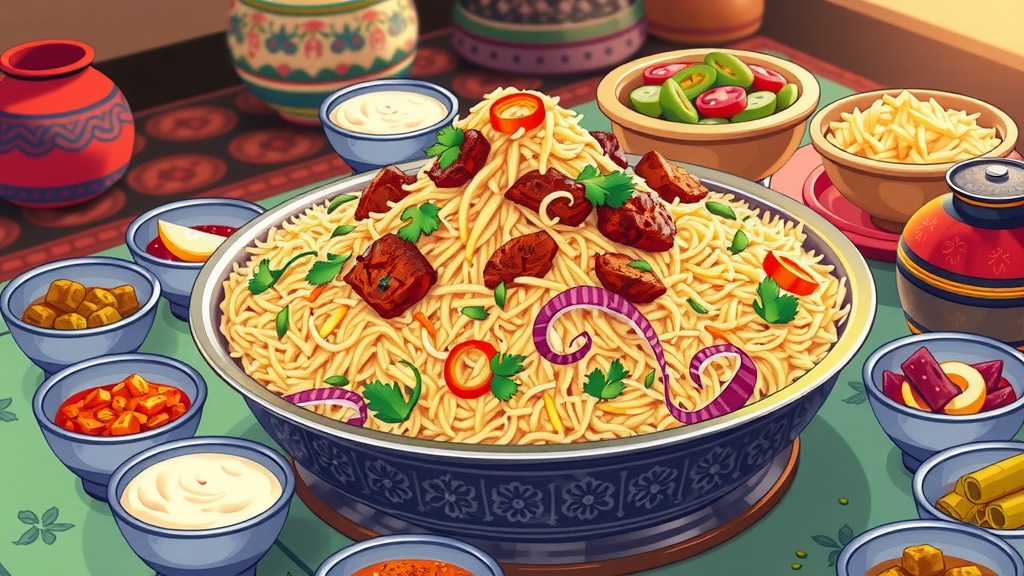In Bangladesh, where the aroma of spices dances through the air and culinary traditions are as rich as our history, food isn't just sustenance; it's an emotion. From the bustling streets of Dhaka to the serene villages nestled beside the Padma, the love for good food unites us all. But if I had to pick just one dish that truly captures my heart, it would be Biriyani. Yes, that fragrant, flavorful mountain of rice, meat, and spices that makes every occasion feel like a celebration! Let's dive into why Biriyani isn't just my favorite food, but a cultural icon worth writing about.
The Aromatic Allure of Biriyani: My Favourite Food Paragraph
Think about it: the moment Biriyani is served, a symphony of scents fills the air. The earthy aroma of basmati rice mingles with the warm notes of cardamom, cloves, and cinnamon. Each whiff is a promise of the deliciousness to come. For me, Biriyani is more than just food; it's a sensory experience, a culinary hug that warms you from the inside out.
A Culinary Masterpiece: Layers of Flavor and Texture
Biriyani isn't a simple dish; it's a carefully constructed masterpiece. Tender pieces of marinated meat, often chicken, mutton, or beef, are layered with fragrant rice, caramelized onions (beresta), and a medley of spices. The magic happens when it's slow-cooked in a sealed pot (dum), allowing the flavors to meld and deepen.
- The Rice: Long-grain basmati rice is the foundation, each grain separate and fluffy.
- The Meat: Succulent and flavorful, the meat is the star of the show.
- The Spices: A blend of cardamom, cloves, cinnamon, saffron, and other spices creates a complex and aromatic profile.
- The Beresta: Crispy, golden-brown fried onions add a touch of sweetness and texture.
More Than Just a Meal: Biriyani and Bangladeshi Culture
Biriyani holds a special place in Bangladeshi culture. It's the go-to dish for celebrations, from weddings and Eid gatherings to birthdays and graduations. Sharing a plate of Biriyani is a sign of hospitality, generosity, and love. It's a dish that brings people together, fostering a sense of community and belonging.
Imagine a family gathering during Eid. The aroma of Biriyani wafts from the kitchen, drawing everyone together. Laughter and conversations fill the air as family members share stories and enjoy the delicious meal. In these moments, Biriyani becomes more than just food; it's a symbol of togetherness and tradition.
Crafting Your Own "My Favourite Food" Paragraph: A Guide
Now, let's explore how you can write your own compelling "My Favourite Food" paragraph, whether you're in Class 6, preparing for your SSC or HSC exams, or simply want to express your love for a particular dish. We'll cover different word counts (150, 250, and 300 words) and provide tips to make your writing stand out.
My Favourite Food Paragraph for Class 6-8 (150 Words)
My favorite food is Biriyani. It's a special dish made with rice, meat, and lots of spices. The smell of Biriyani is so good, it makes my mouth water! The rice is long and fluffy, and the meat is very tender. My mother cooks Biriyani on special days like Eid or birthdays. Eating Biriyani with my family makes me happy. I love the taste of the spices, especially cardamom and cloves. Sometimes, we add potatoes and eggs to it. Biriyani is not just a food; it's a celebration in my mouth! It makes every occasion more joyful and memorable. That's why Biriyani is my favorite food.
Bangla Meaning:
আমার প্রিয় খাবার বিরিয়ানি। এটি চাল, মাংস এবং অনেক মশলা দিয়ে তৈরি একটি বিশেষ খাবার। বিরিয়ানির গন্ধ এত ভালো যে আমার জিভে জল এসে যায়! চাল লম্বা ও নরম, এবং মাংস খুবই নরম। আমার মা ঈদ বা জন্মদিনের মতো বিশেষ দিনে বিরিয়ানি রান্না করেন। পরিবারের সাথে বিরিয়ানি খেতে আমার খুব ভালো লাগে। আমি মশলার স্বাদ পছন্দ করি, বিশেষ করে এলাচ এবং লবঙ্গ। কখনও কখনও, আমরা এতে আলু এবং ডিম যোগ করি। বিরিয়ানি শুধু একটি খাবার নয়; এটা আমার মুখের মধ্যে একটি উৎসব! এটি প্রতিটি উপলক্ষকে আরও আনন্দময় এবং স্মরণীয় করে তোলে। তাই বিরিয়ানি আমার প্রিয় খাবার।
My Favourite Food Paragraph for Class 9-10, SSC (250 Words)
Biriyani, without a doubt, holds the top spot as my favorite food. This iconic dish is a symphony of flavors, textures, and aromas that always manages to captivate my senses. Originating from the Mughal kitchens, Biriyani has become an integral part of Bangladeshi cuisine and culture. It's more than just a meal; it's an experience.
The preparation of Biriyani is an art in itself. Long-grain basmati rice is layered with marinated meat (usually chicken, mutton, or beef), caramelized onions (beresta), and a blend of aromatic spices like cardamom, cloves, cinnamon, and saffron. The dish is then slow-cooked in a sealed pot, allowing the flavors to meld together and create a truly unforgettable taste.
What I love most about Biriyani is its versatility. There are countless variations, each with its unique twist. Be it the spicy Hyderabadi Biriyani, the fragrant Lucknowi Biriyani, or the comforting Dhaka-style Kacchi Biriyani, there's a Biriyani for every palate.
Biriyani is not just a dish I enjoy eating; it's a dish that evokes memories of family gatherings, celebrations, and special occasions. The aroma of Biriyani wafting through the air always brings a smile to my face and a feeling of warmth to my heart. It's a dish that truly embodies the spirit of Bangladeshi hospitality and culinary excellence.
Bangla Meaning:
বিরিয়ানি, নিঃসন্দেহে, আমার প্রিয় খাবার হিসেবে শীর্ষস্থান দখল করে আছে। এই খাবারটি স্বাদ, গঠন এবং গন্ধের একটি সিম্ফনি যা সবসময় আমার ইন্দ্রিয়কে মোহিত করে। মুঘল রান্নাঘর থেকে উদ্ভূত, বিরিয়ানি বাংলাদেশের খাবার এবং সংস্কৃতির একটি অবিচ্ছেদ্য অংশ হয়ে উঠেছে। এটি কেবল একটি খাবার নয়; এটি একটি অভিজ্ঞতা।
বিরিয়ানি তৈরি করা নিজেই একটি শিল্প। লম্বা বাসমতী চাল ম্যারিনেট করা মাংস (সাধারণত মুরগি, খাসি বা গরুর মাংস), ক্যারামেলাইজড পেঁয়াজ (বেরেস্তা) এবং এলাচ, লবঙ্গ, দারুচিনি এবং জাফরানের মতো সুগন্ধি মশলার মিশ্রণের সাথে স্তূপ করে দেওয়া হয়। এরপর খাবারটি একটি সিল করা পাত্রে ধীরে ধীরে রান্না করা হয়, যা স্বাদগুলোকে একত্রিত হতে এবং সত্যিকারের অবিস্মরণীয় স্বাদ তৈরি করতে দেয়।
বিরিয়ানির সবচেয়ে ভালো দিক হল এর বহুমুখিতা। এর অসংখ্য প্রকারভেদ রয়েছে, প্রত্যেকটির নিজস্ব অনন্যতা রয়েছে। সেটা মশলাদার হায়দ্রাবাদী বিরিয়ানি, সুগন্ধি লখনউই বিরিয়ানি, বা আরামদায়ক ঢাকাই কাচ্চি বিরিয়ানি যাই হোক না কেন, প্রতিটি স্বাদের জন্য একটি বিরিয়ানি রয়েছে।
বিরিয়ানি শুধু একটি খাবার নয় যা আমি খেতে উপভোগ করি; এটি এমন একটি খাবার যা পারিবারিক মিলন, উদযাপন এবং বিশেষ অনুষ্ঠানের স্মৃতি মনে করিয়ে দেয়। বিরিয়ানির সুগন্ধ বাতাসে ভেসে আসা সবসময় আমার মুখে হাসি ফোটায় এবং আমার হৃদয়কে উষ্ণতায় ভরে তোলে। এটি এমন একটি খাবার যা সত্যিই বাংলাদেশী আতিথেয়তা এবং রন্ধনসম্পর্কীয় শ্রেষ্ঠত্বের চেতনাকে মূর্ত করে।
My Favourite Food Paragraph for Class 11-12, HSC (300 Words)
My culinary heart belongs to Biriyani, a dish that transcends mere sustenance and embodies the rich tapestry of Bangladeshi culture and tradition. More than just a meal, Biriyani is an experience, a celebration of flavors, and a symbol of togetherness.
The origins of Biriyani can be traced back to the Mughal era, when it was introduced to the Indian subcontinent. Over time, it has evolved and adapted to local tastes and ingredients, resulting in a diverse range of regional variations. In Bangladesh, Biriyani has become a staple dish, gracing the tables of homes and restaurants alike.
The preparation of Biriyani is a labor of love, requiring patience, skill, and attention to detail. The process begins with marinating the meat (typically chicken, mutton, or beef) in a blend of yogurt, ginger-garlic paste, and a medley of aromatic spices. The marinated meat is then layered with parboiled basmati rice, caramelized onions (beresta), and a generous sprinkling of spices like cardamom, cloves, cinnamon, and saffron. The dish is then slow-cooked in a sealed pot over low heat, allowing the flavors to meld together and infuse the rice with their aromatic essence. This slow-cooking process, known as "dum," is what gives Biriyani its distinctive flavor and texture.
What sets Biriyani apart from other rice dishes is its complexity and depth of flavor. The combination of tender meat, fragrant rice, and aromatic spices creates a symphony of tastes that tantalizes the taste buds. The caramelized onions add a touch of sweetness, while the spices provide warmth and complexity. Each bite is a burst of flavor, a culinary journey that transports you to another world.
Biriyani is more than just a delicious dish; it's a cultural icon that holds a special place in the hearts of Bangladeshis. It's the go-to dish for celebrations, weddings, and other special occasions. Sharing a plate of Biriyani is a sign of hospitality, generosity, and friendship. It's a dish that brings people together, fostering a sense of community and belonging. The aroma of Biriyani wafting through the air evokes memories of happy times and cherished moments. It's a dish that truly embodies the spirit of Bangladeshi culture and culinary heritage.
Bangla Meaning:
আমার রন্ধনসম্পর্কীয় হৃদয় বিরিয়ানির অন্তর্গত, এমন একটি খাবার যা নিছক ভরণপোষণকে ছাড়িয়ে যায় এবং বাংলাদেশী সংস্কৃতি ও ঐতিহ্যের সমৃদ্ধ চিত্রকে মূর্ত করে তোলে। নিছক একটি খাবারের চেয়েও বেশি, বিরিয়ানি হল একটি অভিজ্ঞতা, স্বাদের উদযাপন এবং ঐক্যের প্রতীক।
বিরিয়ানির উৎপত্তি মুঘল যুগে খুঁজে পাওয়া যায়, যখন এটি ভারতীয় উপমহাদেশে প্রবর্তিত হয়েছিল। সময়ের সাথে সাথে, এটি স্থানীয় স্বাদ এবং উপাদানের সাথে বিকশিত এবং অভিযোজিত হয়েছে, যার ফলে বিভিন্ন আঞ্চলিক প্রকার তৈরি হয়েছে। বাংলাদেশে, বিরিয়ানি একটি প্রধান খাবারে পরিণত হয়েছে, যা বাড়ি এবং রেস্তোরাঁ উভয়ের টেবিলে শোভা পায়।
বিরিয়ানি তৈরি করা ভালোবাসার শ্রম, যার জন্য ধৈর্য, দক্ষতা এবং বিস্তারিত মনোযোগ প্রয়োজন। প্রক্রিয়াটি শুরু হয় মাংসকে (সাধারণত মুরগি, খাসি বা গরুর মাংস) দই, আদা-রসুনের পেস্ট এবং সুগন্ধি মশলার মিশ্রণে ম্যারিনেট করার মাধ্যমে। ম্যারিনেট করা মাংস তারপর পারবোiled বাসমতি চাল, ক্যারামেলাইজড পেঁয়াজ (বেরেস্তা) এবং এলাচ, লবঙ্গ, দারুচিনি এবং জাফরানের মতো মশলার উদার ছিটিয়ে স্তূপ করে দেওয়া হয়। এরপর খাবারটি কম আঁচে একটি সিল করা পাত্রে ধীরে ধীরে রান্না করা হয়, যা স্বাদগুলোকে একত্রিত হতে এবং চালকে তাদের সুগন্ধী নির্যাস দিয়ে পরিপূর্ণ করতে দেয়। এই ধীর রান্নার প্রক্রিয়া, যা "দম" নামে পরিচিত, বিরিয়ানিকে তার স্বতন্ত্র স্বাদ এবং গঠন দেয়।
অন্যান্য চালের খাবার থেকে বিরিয়ানিকে যা আলাদা করে তা হল এর জটিলতা এবং স্বাদের গভীরতা। কোমল মাংস, সুগন্ধি চাল এবং সুগন্ধি মশলার সংমিশ্রণ এমন স্বাদের একটি সিম্ফনি তৈরি করে যা স্বাদকোষকে মোহিত করে। ক্যারামেলাইজড পেঁয়াজ কিছুটা মিষ্টি যোগ করে, যেখানে মশলা উষ্ণতা এবং জটিলতা প্রদান করে। প্রতিটি কামড় স্বাদের বিস্ফোরণ, একটি রন্ধনসম্পর্কীয় যাত্রা যা আপনাকে অন্য জগতে নিয়ে যায়।
বিরিয়ানি শুধু একটি মুখরোচক খাবার নয়; এটি একটি সাংস্কৃতিক আইকন যা বাংলাদেশিদের হৃদয়ে একটি বিশেষ স্থান করে নিয়েছে। এটি উদযাপন, বিবাহ এবং অন্যান্য বিশেষ অনুষ্ঠানের জন্য পছন্দের খাবার। বিরিয়ানির একটি প্লেট ভাগ করা আতিথেয়তা, উদারতা এবং বন্ধুত্বের লক্ষণ। এটি এমন একটি খাবার যা মানুষকে একত্রিত করে, সম্প্রদায় এবং অন্তর্ভুক্তির অনুভূতি জাগায়। বাতাসে ভেসে আসা বিরিয়ানির সুগন্ধ সুখী সময়ের এবং লালিত মুহূর্তের স্মৃতি মনে করিয়ে দেয়। এটি এমন একটি খাবার যা সত্যিই বাংলাদেশী সংস্কৃতি এবং রন্ধনসম্পর্কীয় ঐতিহ্যের চেতনাকে মূর্ত করে।
SEO Optimization: Keywords in Action
Let's see how we've naturally integrated our main keyword ("My Favourite Food Paragraph for Class 6-12, SSC, HSC, 150, 250, 300 Words") and related terms throughout the content:
- Title: Directly incorporates the main keyword.
- Headings & Subheadings: Used variations of the keyword to structure the content and improve searchability.
- Body Text: Integrated the keyword and related terms organically within the paragraphs, ensuring readability and relevance.
Frequently Asked Questions (FAQs) About My Favourite Food Paragraph
Let's address some common questions students and readers might have about writing their own "My Favourite Food" paragraphs:
Q: How do I choose my favorite food to write about?
Choosing your favorite food is the first step! Think about a dish that you genuinely enjoy and that evokes strong emotions or memories. It could be a simple comfort food or a more elaborate dish. The key is to choose something you can write about with passion and enthusiasm.
Example: Instead of just saying "I like pizza," think about why you like pizza. Is it the crispy crust, the tangy tomato sauce, or the gooey cheese?
Q: What details should I include in my paragraph?
Include details that appeal to the senses: sight, smell, taste, touch, and even sound. Describe the appearance of the dish, its aroma, the flavors that dance on your tongue, and the textures that delight your palate.
Example: Instead of saying "Biriyani smells good," try "The aroma of Biriyani, a blend of cardamom, cloves, and cinnamon, fills the air, making my mouth water."
Q: How can I make my paragraph more engaging?
Use vivid language, sensory details, and personal anecdotes to make your paragraph more engaging. Share a story or memory associated with the dish to connect with your readers on an emotional level.
Example: "Eating jalebis always reminds me of the street fairs I used to visit with my grandfather. The sweet, syrupy taste and the crispy texture bring back those cherished memories."
Q: How do I write a "My Favourite Food" paragraph in 150 words?
Focus on the essentials. Briefly introduce your favorite food, describe its key characteristics (taste, smell, appearance), and explain why you love it. Keep your sentences concise and to the point.
Example: "My favorite food is mango. Its sweet, juicy flesh is a taste of summer. The vibrant yellow color and the tropical aroma make it irresistible. I love eating mangoes straight from the tree, feeling the sticky juice run down my chin. It's a simple pleasure that brings me immense joy."
Q: How do I write a "My Favourite Food" paragraph in 250 words?
Expand on the details. Provide more information about the dish's origin, preparation, and cultural significance. Include personal anecdotes and sensory descriptions to create a more immersive experience for your readers.
Example: "Pitha, a traditional Bangladeshi cake, holds a special place in my heart. Made from rice flour, coconut, and jaggery, pitha comes in various shapes and flavors. My grandmother used to make pitha during winter, and the aroma of freshly baked pitha would fill our home with warmth and love. Each bite is a reminder of my childhood and the traditions that bind us together."
Q: How do I write a "My Favourite Food" paragraph in 300 words?
Delve deeper into the topic. Explore the dish's history, cultural significance, and personal connection in greater detail. Use figurative language and vivid imagery to create a compelling and memorable paragraph.
Example: "Haleem, a hearty stew made from wheat, lentils, and meat, is my ultimate comfort food. Its rich, savory flavor and thick, creamy texture warm me from the inside out. Haleem is a dish that requires hours of slow cooking, allowing the flavors to meld together and create a symphony of tastes. It's often garnished with fried onions, ginger, and lemon juice, adding layers of complexity to the dish. Eating haleem is like receiving a warm hug on a cold day, a reminder that even in the midst of chaos, there is always comfort to be found."
Q: Can I use humor in my "My Favourite Food" paragraph?
Absolutely! Humor can make your paragraph more engaging and memorable. However, use it sparingly and make sure it's appropriate for your audience.
Example: "I'm convinced that chocolate was invented by angels. It's the perfect solution to any problem, whether it's a bad day at school or a broken heart. I'm not ashamed to admit that I have a serious chocolate addiction, but hey, at least it's a delicious addiction!"
Q: How can I improve my writing skills for paragraph writing?
Practice makes perfect! Read examples of well-written paragraphs, pay attention to the language and structure, and try to emulate them in your own writing. Ask for feedback from teachers, friends, or family members to identify areas for improvement.
Q: What are some common mistakes to avoid when writing a "My Favourite Food" paragraph?
- Being too general: Avoid vague statements like "It tastes good." Be specific about the flavors, textures, and aromas.
- Listing ingredients without describing the experience: Don't just list the ingredients; describe how they come together to create a unique and memorable dish.
- Not proofreading: Always proofread your paragraph for errors in grammar, spelling, and punctuation.
- Plagiarism: Ensure your work is original and avoid copying from other sources.
Q: How to write about my favorite food in Bangla?
Writing about your favorite food in Bangla involves using rich, descriptive language that appeals to the senses. Focus on the cultural significance of the dish and how it connects to your personal experiences. Use idiomatic expressions and local references to make your writing relatable and engaging.
Example:
"আমার প্রিয় খাবার হলো মায়ের হাতের রান্না করা খিচুড়ি। বর্ষার দিনে গরম গরম খিচুড়ি আর ডিম ভাজা—যেন অমৃত! খিচুড়ির সুগন্ধ, নরম চালের সাথে ডালের মিশেল, আর মায়ের ভালোবাসা—সব মিলিয়ে এটা শুধু খাবার নয়, একটা অনুভূতি।"
(Translation: My favorite food is Khichuri cooked by my mother. Hot Khichuri with fried eggs on a rainy day—it's like nectar! The aroma of Khichuri, the mixture of soft rice and lentils, and my mother's love—all together, it's not just food, it's a feeling.)
Table: Comparing "My Favourite Food" Paragraph Examples
| Feature | 150 Words (Class 6-8) | 250 Words (Class 9-10, SSC) | 300 Words (Class 11-12, HSC) |
|---|---|---|---|
| Focus | Basic description | More detailed description | In-depth analysis |
| Language | Simple, direct | Slightly more complex | Sophisticated, figurative |
| Details | Few sensory details | More sensory details | Rich sensory details |
| Anecdotes | Minimal | Some personal anecdotes | Detailed personal anecdotes |
| Cultural Context | Briefly mentioned | More emphasis on culture | Strong cultural emphasis |
Tips for Writing a Stellar "My Favourite Food" Paragraph
Here are some additional tips to help you craft a truly exceptional "My Favourite Food" paragraph:
- Show, don't tell: Instead of saying "It's delicious," describe why it's delicious.
- Use strong verbs: Choose verbs that are active and evocative, such as "sizzle," "melt," or "burst."
- Vary your sentence structure: Use a mix of short and long sentences to create a more dynamic rhythm.
- Read your paragraph aloud: This will help you identify any awkward phrasing or grammatical errors.
- Get feedback: Ask someone to read your paragraph and provide constructive criticism.
Beyond Biriyani: Exploring Other Culinary Delights
While Biriyani holds a special place in my heart, Bangladesh offers a treasure trove of other culinary delights. Here are a few other dishes that are worth exploring:
- Pitha: Traditional rice cakes, often made with coconut and jaggery.
- Haleem: A hearty stew made from wheat, lentils, and meat.
- Fish Curry: A flavorful curry made with various types of fish and spices.
- Bhuna: A dry, flavorful meat dish cooked with onions, ginger, and garlic.
- Rasgulla: A soft, spongy cheese ball soaked in syrup.
The Enduring Appeal of Food Writing
Writing about food is more than just describing flavors and textures; it's about sharing a part of yourself with the world. It's about connecting with others through a shared love of culinary experiences. Whether you're writing a simple paragraph for school or a more elaborate essay for a food blog, the key is to write with passion, honesty, and a genuine appreciation for the art of cooking and eating.
So, the next time you sit down to write about your favorite food, remember to engage all your senses, tap into your memories, and let your creativity flow. Who knows, you might just inspire someone to try a new dish or rediscover an old favorite!
In conclusion, writing about your favorite food is a delightful journey that allows you to express your passion, connect with your culture, and share your unique perspective with the world. Whether you choose to write about Biriyani, Pitha, or any other dish that holds a special place in your heart, remember to use vivid language, sensory details, and personal anecdotes to create a compelling and memorable paragraph. Now, go forth and share your culinary love story with the world! What's your favorite food and why? Share in the comments below!




